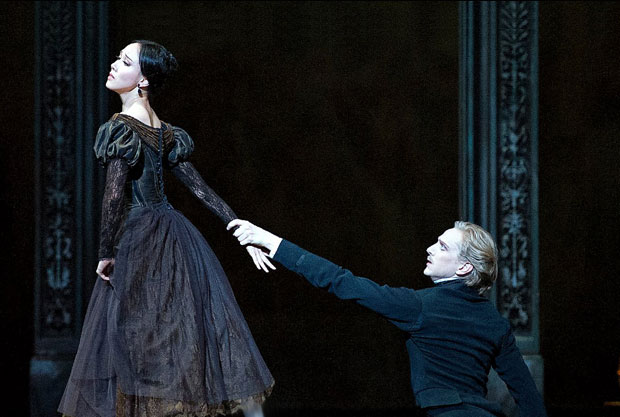
So She Was Called Tanya
American Ballet Theatre
Onegin
New York, Metropolitan Opera House
June 2012
www.abt.org
Like bookworms and moviegoers, ballet audiences are not a single, undifferentiated mass, but an odd mélange of people seeking different types of pleasure (and pain). If you love murder mysteries, you’re not likely to enjoy existential novels, and vice versa. And the same goes for ballet. Some audiences come seeking performances of the classics, which should be tampered with as little as possible. Others crave innovation, new works by younger choreographers bent on tweaking the boundaries of the art. Yet others – the formalists, let’s say – are hungry for the satisfactions of structure and phrasing, and the ways in which the steps interact with the music. Some go in for originality, others like bravura. And then there are the romantics – and there are a lot of them – who go to the ballet to see larger-than-life passions played out on the stage by the extraordinary beings we call dancers. They want to be carried away on a wave of emotion, the bigger the better. These are the audiences who, for decades, have embraced the works of John Cranko, Kenneth MacMillan and John Neumeier. This week, they are filling the Metropolitan Opera House to see Cranko’s “Onegin,” as performed by four different casts of American Ballet Theatre’s finest dancers.
Ballet is uniquely suited to satisfy a desire for Romance: with their refined, articulate physiques and their ability to move in ways the rest of us can only imagine in our dreams, dancers are able to give bodily form to our loftiest thoughts and feelings. The pointe shoe – and the elongation of the body it allows – further magnifies the effect. An extravagantly arched back conveys longing; a limpid arabesque communicates purity; a perfectly executed pirouette is the embodiment of poise. And then, as in ice-dancing and competitive ballroom dance, there are the lifts, a well-worn metaphor for the heights of male-female passion. (Unlike on the competition circuit, however, in “serious” ballets these lifts are not meant to be celebrated for the technique that goes into their execution, but rather experienced as pure expressions of feeling.)
In this respect, Cranko’s “Onegin” is an effective vehicle for Pushkin’s love story and the emotions described therein: the reaching, the swoons, the desperate runs, and most of all, the lifts in which the female dancer’s body becomes a tragic, expressive figure in the male dancer’s hands. Cranko ably tells the story of Pushkin’s “Onegin” – a cautionary tale about a bored St. Petersburg dandy who comes face to face with a pure, child-like love and is unable to recognize it until it is too late. We may not get the subtleties of Pushkin – the satire of Russian high-society or the complicated emotions behind the characters’s actions – but that would be too much too ask. In Cranko’s telling, it is never less than clear what is going on, and the pacing of the ballet, which is divided into three acts, is excellent. At two-and-a-half hours, including two intermissions, it never drags.
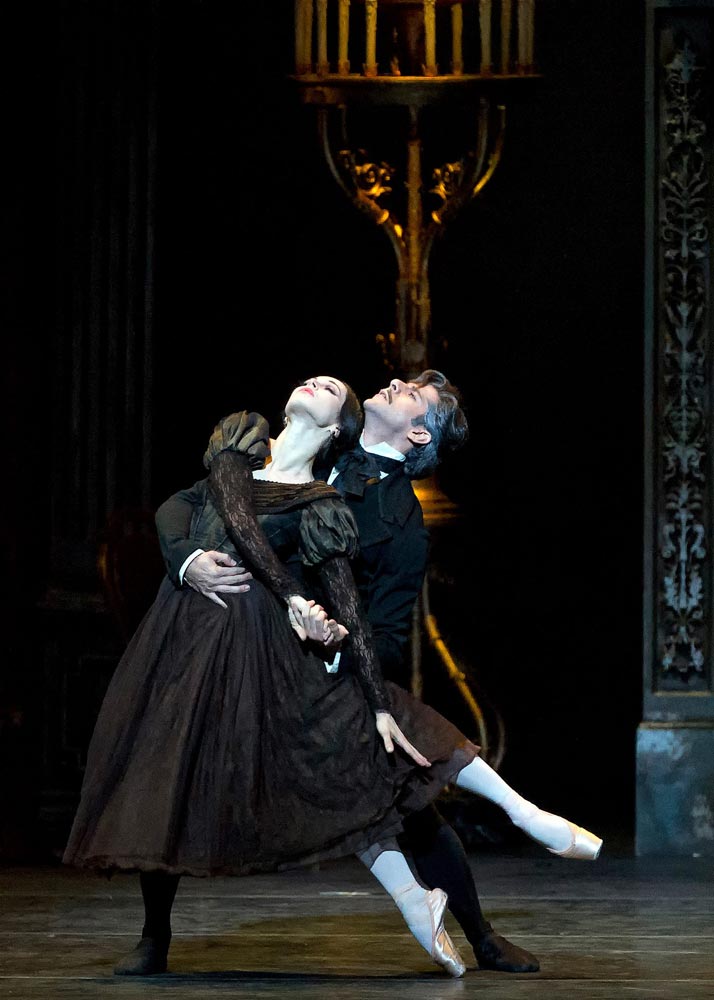
And yet, even on its own terms, it leaves one wanting, despite the performances of two excellent casts. (On June 4, Onegin was danced by Marcelo Gomes, and Tatyana by the beautiful Diana Vishneva; Olga was Natalia Osipova, with Jared Matthews as Lensky. On June 5, the roles were played by David Hallberg, Hee Seo, Yuriko Kajiya, and Joseph Gorak, in a stunning début as Lensky.) And it does not blossom with repeated viewing. Much to the contrary. What are its short-comings? First, the music, a hodge-podge of Tchaikovsky pieces (mostly composed for the piano), arranged and re-orchestrated by Kurt-Heinz Stolze. As Stolze has written, the pieces have been “changed harmonically and rhythmically” to serve the dramatic structure of the ballet. The result is never less than pretty, but often bland. The music for the two pas de deux for Onegin and Tatyana, especially, has been reduced to a series of wave-like crescendi. Oddly, the most compelling piece, a lilting Russian melody, accompanies a pas de deux for Tatyana’s flirtatious younger sister Olga and her fiancé, the idealistic Lensky. Which brings us to another oddity in the ballet: a strange imbalance of emphasis in which Tatyana and Onegin often get lost in the fray. Some of this is implicit in the plot. In Charles Johnston’s translation, Pushkin writes, of Tatyana: “Truly she lacked her sister’s beauty, lacked the rosy bloom that glowed so newly to catch the eye and to attract. Shy as a savage, silent, tearful, wild as a forest deer, and fearful, Tatyana had a changeling look in her own home.” How can she compete with the vivacious Olga? And, in the role of Onegin, how does one depict boredom in dance? A slow walk, a faraway look, a hand to the brow (“how could he be expected…to spout witticisms when his head ached?”). Cranko’s faithfulness to these desriptions has the strange effect of turning the main characters into recessive players for most of the first two acts; even in the third, Tatyana’s most radiant dancing is with her husband, not Onegin. One might be forgiven for thinking that the ballet is really about Olga and Lensky, especially when, as on June 4, Olga is played, with hard-edged ferocity, by Natalia Osipova.
Equally problematic is the fact that key moments in the story – the duel between Lensky and Onegin, for example, and Tatyana’s final rejection of Onegin – pass by in a flash, while the build-up, usually involving copious gesticulation and anguished partnering, goes on and on. The duel, a perfect opportunity for imaginative choreography – as we just saw in Ratmansky’s “Bright Stream” – happens in the blink of an eye, at the rear of the stage, with little fuss (Cranko did not even bother to provide the duelers with seconds). To precede it, he created a long, fussy trio in which the two anguished sisters – heads covered in scarves – push and pull at Lensky and implore him to lay down his weapon. The pre-duel dancing is pointless and a little silly-looking (I was reminded of the tongue-in-cheek pushing and pulling in Balanchine’s “Midsummer Night’s Dream.” ) And then it’s all over; Lensky crumples to the ground, end of Act II.
And again, in the final, climactic pas de deux in which Onegin – now madly in love with Tatyana – declares his abject adoration (she’s now married), there is a similar imbalance. For most of the scene, Onegin is at Tatyana’s feet, while Tatyana can be seen either dragging herself from his arms or throwing herself into them. (Cranko’s partnering here is quite brutal, with the dancer playing Onegin often gripping the ballerina by the forearms or yanking her about with her arms stretched behind her back.) The drama eventually escalates into a series of lifts in which the ballerina’s body has the look of a broken doll. Again, as with the re-orchestrated music, we get a series of aimless crescendi, all of which say the same thing: they love each other but their love is doomed.
And then, Tatyana’s actual rejection takes only an instant: she points to the door, and off he goes, running desperately, only to cross the back of the stage one last time, still running like the wind. In the Pushkin, Onegin “all emotion, stood thunder-struck. In what wild round of tempests, in what raging ocean his heart was plunged! A sudden sound, the clink of rowels, met his hearing; Tatyana’s husband, now appearing…” But Cranko prefers melodrama over emotional truth. There is a place for melodrama, of course; in fact, this same pas de deux contains one of the most effective melodramatic gestures I have ever seen in a ballet: the moment in which Onegin encircles Tatyana with his arms and then slowly lowers himself to the floor, a gesture of such worshipful abasement that it brought a tear to my eye. How can one not react thus when seeing David Hallberg – a paragon of nobility and grace – begging on his knees to be loved? But where does one go from there?
If I haven’t mentioned the ensemble dances until now, it’s because there isn’t much to say. Much generic mazurka-ing and waltzing goes on; in the first act, Olga and her friends partake in a playful Russian dance with the men squatting arm-in-arm, and the girls shuffling and skipping in a circle. The old folk do a little doddering dance at Tatyana’s birthday party, but again, the characterizations have little to distinguish them. Olga and Lensky have some lovely dances, especially their mournful pas de deux in the first act, which contains perhaps the most satisfyingly musical steps in the whole ballet. Lensky’s solo before the duel is another highlight, if only because it allows the dancer to show his legato line and phrasing – something which Onegin has almost no opportunity to do. In the June 5 cast, Yuriko Kajiya and Joseph Gorak danced well; Kajiya was sweetly luminous and expansive, but bland. The real standout was Gorak. Still in the corps, he has been given a few featured roles in recent seasons, but this was a major début, and he was simply extraordinary. The execution was silky-smooth, his turns with one leg extended to the side or behind him radiated beautifully, without the slightest hesitation or wobble or hint of tension. And he has a quiet gravity that makes him all the more interesting to watch. Just gorgeous.

In the first cast, Osipova’s rendering of Olga was avid and over-emphatic, with a rictus smile that gleamed to the furthest reaches of the theatre. She was not at all Pushkin’s sweet, if superficial girl, who “blossomed in the graceful ways of innocence, a lily blooming in deepest grasses.” Diana Vishneva, however, fully captured the essence of Tatyana, a romantic dreamer, shy to the point of awkwardness, burning to be loved. As always, she danced as if inventing the steps anew, giving of herself with abandon in the pas de deux. She and Marcelo Gomes have a great partnership, his ardor and presence giving free reign to her expressivity. In the scene in which he returns her letter and rejects her childish declarations of love, she looked dead, empty, spent. For his part Gomes, made a dashing Onegin, deadly handsome in his black costumes (by Santo Loquasto). But the character doesn’t really suit him; it’s a strain for such a warm, engaging dancer to appear bored and cold. (He was much more at home in the duets, of course.) David Hallberg, with his Nordic looks and long lean physique, had just the right hauteur; he is a born Onegin. But he’s wasted in the role; one can’t get over the feeling that one never really gets to see him dance, what with all that mooning around and heavy lifting he has to do. Hee Seo, the more naturalistic of the two Tatyana’s, gave a touching vulnerability and simplicity to her interpretation. Perhaps a bit too much; she got lost in the shuffle. But she’ll surely grow in the role.
This production, which premièred at the National Ballet of Canada in 2010, has new sets and costumes by Santo Loquasto and elegant, if somewhat dim, lighting by James F. Ingalls. The sets were attractive, with bare birch trees littering the sides of the stage to evoke the Russian countryside and elaborate, sumptuous interiors. I was particularly partial to the stormy clouds that loomed over the duel scene. On the other hand, I found it quite annoying that a scrim with the title “Eugene Onegin” (in Cyrillic) was lowered several times throughout the ballet, as if one might have forgotten what one was seeing.
In any case, the Romantics were satisfied. Both performances I saw were warmly received and well-sold. But I could not help thinking, as I left the theatre: “bliss was so near, so altogether attainable!”












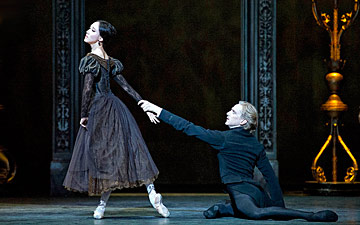


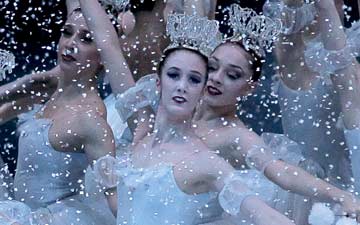
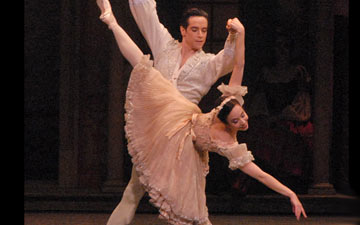
Keenly observed.
A very insightful review. I agree with your analysis of the choreography. San Francisco Ballet (my home company) did this version of Onegin last season and are doing it again next year ( story ballets are very “in” right now in, unfortunately for me). I think of myself as a romantic, but I am not a particular fan of the choreographers you mention. Some of us go to ballet primarily for the dancers, and SFB dancers saved Onegin for me, but the structural problems you describe are very real. Thank you.
Dear Brendan, thank you so much for note. It does seem to be that dancers (at least some dancers) love to perform Onegin, thereby allowing us to see sides of them we would not normally get to see… But if one goes mainly for choreography…
Cheers!